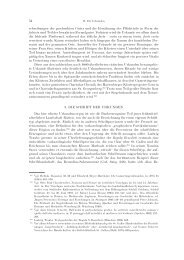Chapter Three ANTHOLOGIES AND ANTHOLOGISTS Between c ...
Chapter Three ANTHOLOGIES AND ANTHOLOGISTS Between c ...
Chapter Three ANTHOLOGIES AND ANTHOLOGISTS Between c ...
You also want an ePaper? Increase the reach of your titles
YUMPU automatically turns print PDFs into web optimized ePapers that Google loves.
120<br />
Part One: Texts and Contexts<br />
11. 284: (king Amphion) Ýß pot\ n \Orcomen/ Minye5ù Éói 4nassen [cf. v. 12: (Leo)<br />
c0ron pikrat6zn te palaió1toy \Orcomeno¦o]. The poet was also familiar with<br />
the Greek Anthology: qeod6gmzn, a hapax recorded in AP VII, 363. 4; kaò oJ<br />
lal6onta, cf. APl 30. 4; p\ äpe5rona k7kla, cf. AP IX, 468. 3; mhtrñß<br />
äpeirog1moy, cf. AP I, 2. 3, 27. 3 and 99. 6; xet6lessaß, cf. APl 43. 3 (in the<br />
same metrical position); s0n kam1tzn, cf. AP I, 9. 1; kaò töde g2r t6menoß<br />
panao5dimon xet6lessaß, cf. AP I, 9. kaò töde s0n kam1tzn panao5dimon Çrgon<br />
t7cqh. Is this the work of a local poet? Perhaps, but given the superb literary<br />
quality of the verses it seems more likely that the palace official Leo the<br />
Protospatharios (the subject of the poem) commissioned a Constantinopolitan<br />
poet to compose this elegant verse inscription 125 . The second classicistic verse<br />
inscription is an early tenth-century epitaph found on a sarcophagus in the<br />
vicinity of Galakrenai, the monastery of the Patriarch Nicholas Mystikos 126 .<br />
The patriarch’s synkellos, Michael, is commemorated in the epitaph. The poem<br />
is remarkable for its use of Nonnian phrases, Homeric tags and explicit borrowings<br />
from the Greek Anthology. See, for instance, the following two macaronic<br />
verses (vv. 3–4): 4cqoß äporr5vaß (AP VII, 19. 4) bebarhöta (Homer and later<br />
epic writers) desmñn äl7xaß (Od. 8. 353) / possòn laórot1toisi (Nonnos, Dion.<br />
28. 287, 32. 246, Par. Ev. Ioh. 19. 21) di6sticen (Nonnos, passim), ¼ci core7ei<br />
(Nonnos, Dion. 3. 110) 127 . Seeing that Alexander of Nicaea wrote two epitaphs<br />
on Nicholas Mystikos (APl 21–22), he would be a likely candidate if one desired<br />
to attribute this classicistic verse inscription to a known author; at any rate,<br />
the poem “emanated from (…) the same competent literary milieu of high<br />
prelates gravitating around the Great Church” 128 .<br />
However, it must be said that all this classicizing between c. 850 and 950<br />
was very much a Constantinopolitan thing. The epigrams of the Anonymous<br />
Italian, for instance, are not at all classicistic. And even in Constantinople, the<br />
classicizing vogue was not wholeheartedly embraced by all intellectuals. The<br />
epigrams by Leo Choirosphaktes, for instance, are not particularly classicistic.<br />
Strangely enough, though, the same Leo Choirosphaktes was accused of “hellenism”<br />
by Arethas of Caesarea, an author whom we know to have written<br />
extremely classicizing epitaphs. The above is merely intended as a cautious<br />
reminder not to stick stylistic labels on periods. Diverging styles, preferences<br />
and mindsets coexist in Byzantium at any given moment, sometimes peacefully,<br />
sometimes with a lot of sabre-rattling. No period is exclusively this or<br />
that. For instance, the art-historical concept of the “Macedonian Renaissance”<br />
may account for the classicistic style of the Paris Psalter, but ignores other,<br />
125 See also the comments by OIKONOMIDES 1994: 489–492.<br />
126 See ŠEVCENKO 1987: 461–468 and CAMERON 1993: 319.<br />
127 See the excellent commentary by ŠEVCENKO 1987: 462 and 464.<br />
128 ŠEVCENKO 1987: 462.




